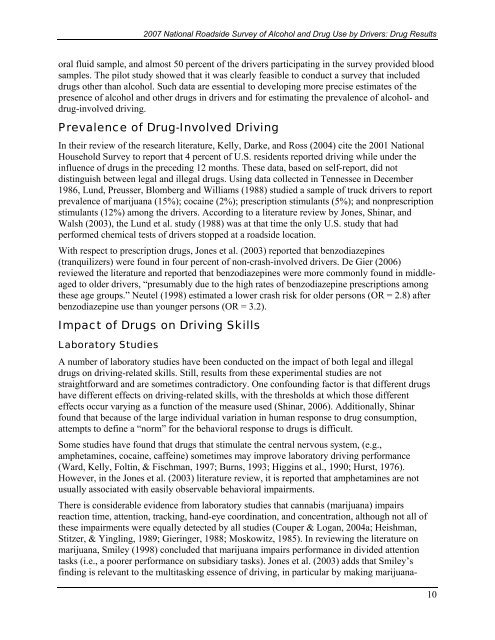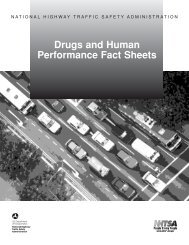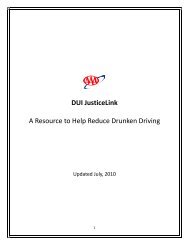2007 National Roadside Survey of Alcohol and Drug Use by Drivers
2007 National Roadside Survey of Alcohol and Drug Use by Drivers
2007 National Roadside Survey of Alcohol and Drug Use by Drivers
You also want an ePaper? Increase the reach of your titles
YUMPU automatically turns print PDFs into web optimized ePapers that Google loves.
<strong>2007</strong> <strong>National</strong> <strong>Roadside</strong> <strong>Survey</strong> <strong>of</strong> <strong>Alcohol</strong> <strong>and</strong> <strong>Drug</strong> <strong>Use</strong> <strong>by</strong> <strong>Drivers</strong>: <strong>Drug</strong> Resultsoral fluid sample, <strong>and</strong> almost 50 percent <strong>of</strong> the drivers participating in the survey provided bloodsamples. The pilot study showed that it was clearly feasible to conduct a survey that includeddrugs other than alcohol. Such data are essential to developing more precise estimates <strong>of</strong> thepresence <strong>of</strong> alcohol <strong>and</strong> other drugs in drivers <strong>and</strong> for estimating the prevalence <strong>of</strong> alcohol- <strong>and</strong>drug-involved driving.Prevalence <strong>of</strong> <strong>Drug</strong>-Involved DrivingIn their review <strong>of</strong> the research literature, Kelly, Darke, <strong>and</strong> Ross (2004) cite the 2001 <strong>National</strong>Household <strong>Survey</strong> to report that 4 percent <strong>of</strong> U.S. residents reported driving while under theinfluence <strong>of</strong> drugs in the preceding 12 months. These data, based on self-report, did notdistinguish between legal <strong>and</strong> illegal drugs. Using data collected in Tennessee in December1986, Lund, Preusser, Blomberg <strong>and</strong> Williams (1988) studied a sample <strong>of</strong> truck drivers to reportprevalence <strong>of</strong> marijuana (15%); cocaine (2%); prescription stimulants (5%); <strong>and</strong> nonprescriptionstimulants (12%) among the drivers. According to a literature review <strong>by</strong> Jones, Shinar, <strong>and</strong>Walsh (2003), the Lund et al. study (1988) was at that time the only U.S. study that hadperformed chemical tests <strong>of</strong> drivers stopped at a roadside location.With respect to prescription drugs, Jones et al. (2003) reported that benzodiazepines(tranquilizers) were found in four percent <strong>of</strong> non-crash-involved drivers. De Gier (2006)reviewed the literature <strong>and</strong> reported that benzodiazepines were more commonly found in middleagedto older drivers, “presumably due to the high rates <strong>of</strong> benzodiazepine prescriptions amongthese age groups.” Neutel (1998) estimated a lower crash risk for older persons (OR = 2.8) afterbenzodiazepine use than younger persons (OR = 3.2).Impact <strong>of</strong> <strong>Drug</strong>s on Driving SkillsLaboratory StudiesA number <strong>of</strong> laboratory studies have been conducted on the impact <strong>of</strong> both legal <strong>and</strong> illegaldrugs on driving-related skills. Still, results from these experimental studies are notstraightforward <strong>and</strong> are sometimes contradictory. One confounding factor is that different drugshave different effects on driving-related skills, with the thresholds at which those differenteffects occur varying as a function <strong>of</strong> the measure used (Shinar, 2006). Additionally, Shinarfound that because <strong>of</strong> the large individual variation in human response to drug consumption,attempts to define a “norm” for the behavioral response to drugs is difficult.Some studies have found that drugs that stimulate the central nervous system, (e.g.,amphetamines, cocaine, caffeine) sometimes may improve laboratory driving performance(Ward, Kelly, Foltin, & Fischman, 1997; Burns, 1993; Higgins et al., 1990; Hurst, 1976).However, in the Jones et al. (2003) literature review, it is reported that amphetamines are notusually associated with easily observable behavioral impairments.There is considerable evidence from laboratory studies that cannabis (marijuana) impairsreaction time, attention, tracking, h<strong>and</strong>-eye coordination, <strong>and</strong> concentration, although not all <strong>of</strong>these impairments were equally detected <strong>by</strong> all studies (Couper & Logan, 2004a; Heishman,Stitzer, & Yingling, 1989; Gieringer, 1988; Moskowitz, 1985). In reviewing the literature onmarijuana, Smiley (1998) concluded that marijuana impairs performance in divided attentiontasks (i.e., a poorer performance on subsidiary tasks). Jones et al. (2003) adds that Smiley’sfinding is relevant to the multitasking essence <strong>of</strong> driving, in particular <strong>by</strong> making marijuana-10




